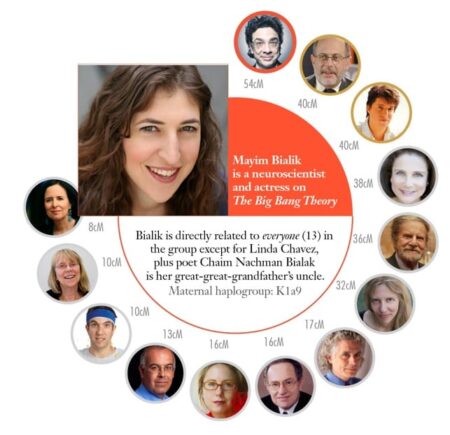
We plead guilty to occasionally geeking out on genetics, so it’s nice to see when someone else does it too.
In September, Moment Magazine got all nerdy and wrote about their Great DNA Experiment, in which they look at the 23andMe results of 15 notable Americans of Jewish ancestry and make some interesting genetic connections. It’s a good illustration of how our DNA can tell us about our interconnectedness.
The piece shows it’s not “six degrees” that separates these individuals from each other, but, in all but one case, no degrees of separation. This means that these individuals are all directly related to one another, albeit in most cases distantly. This was also news to the 15 participants.
All but one of the individuals has Ashkenazi Jewish ancestry. The one exception is Linda Chavez, the political commentator, who descended from Conversos, indivduals of Jewish and Muslim ancestry who converted to Catholicism during the Inquisition. Her ancestors eventually settled in New Mexico. But even in her case, although she isn’t directly related to any of the group, she is connected to each of the others individuals focused on in the piece by just one other individual in the 23andMe database.
The connections shown in the article are what prompted The New York Times columnist David Brooks and NPR “All Things Considered” host Robert Siegel to joke about learning they were distant cousins, sharing a common ancestor several generations back. Brooks kidded that he was “most surprised that our ancestors worked together on National Schetl Radio, on a program called ‘All Pogroms Considered.’” (Maybe the line needs a drum roll to work.)
The article shows the genetic connections between people like Mayim Bialik, the actress on the Big Bang Theory, and Stephen Dubner, co-author of Freakonomics. Or the connections between NPR’s Siegel, and Harvard Law professor, Alan Dershowitz, or his connections to 23andMe’s CEO’s mother Esther Wojcicki, a journalist and teacher. The magazine shows the connections and the amount of shared DNA, measured in centimorgans (cMs), to illustrate the “relatedness” of any two individuals. More closely related individuals share more DNA.
So why is all this interesting?
It is a very specific example of unexpected connectedness. We’ve written about this interconnectedness before. We’ve even seen unexpected connectedness among 23andMe employees. Even in cases with people who have vastly different backgrounds and experiences, one can use genetics to create a short chain of people to connect any two individuals to each other. A little geeky, yes, but pretty cool nonetheless.